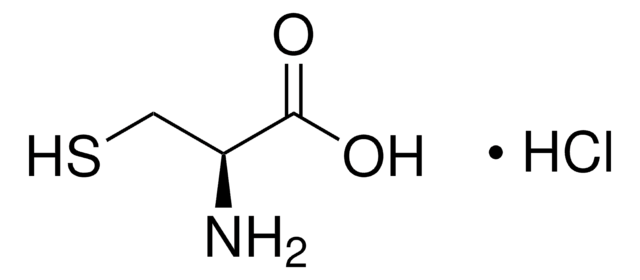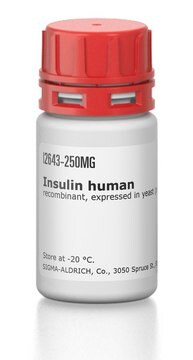V900342
Cysteamine hydrochloride
Vetec™, powder or crystals, 98%
Sinonimo/i:
β-Mercaptoethylamine hydrochloride, 2-Aminoethanethiol hydrochloride, 2-Mercaptoethylamine hydrochloride, Decarboxycysteine hydrochloride, Thioethanolamine hydrochloride
About This Item
Prodotti consigliati
product name
Cysteamine hydrochloride, Vetec™, reagent grade, 98%
Grado
reagent grade
Nome Commerciale
Vetec™
Saggio
98%
Forma fisica
powder or crystals
Punto di fusione
67-71 °C
Solubilità
water: 50 mg/mL, clear, colorless to very faintly yellow
Temperatura di conservazione
2-8°C
Stringa SMILE
Cl[H].NCCS
InChI
1S/C2H7NS.ClH/c3-1-2-4;/h4H,1-3H2;1H
OGMADIBCHLQMIP-UHFFFAOYSA-N
Cerchi prodotti simili? Visita Guida al confronto tra prodotti
Note legali
Avvertenze
Warning
Indicazioni di pericolo
Consigli di prudenza
Classi di pericolo
Acute Tox. 4 Oral - Eye Irrit. 2 - Skin Sens. 1 - STOT SE 3
Organi bersaglio
Respiratory system
Codice della classe di stoccaggio
11 - Combustible Solids
Classe di pericolosità dell'acqua (WGK)
WGK 3
Punto d’infiammabilità (°F)
Not applicable
Punto d’infiammabilità (°C)
Not applicable
Certificati d'analisi (COA)
Cerca il Certificati d'analisi (COA) digitando il numero di lotto/batch corrispondente. I numeri di lotto o di batch sono stampati sull'etichetta dei prodotti dopo la parola ‘Lotto’ o ‘Batch’.
Possiedi già questo prodotto?
I documenti relativi ai prodotti acquistati recentemente sono disponibili nell’Archivio dei documenti.
Il team dei nostri ricercatori vanta grande esperienza in tutte le aree della ricerca quali Life Science, scienza dei materiali, sintesi chimica, cromatografia, discipline analitiche, ecc..
Contatta l'Assistenza Tecnica.





